Schematic

Theory of Operation
The power supply delivers two rails to the receiver. The 5 volt rail (from U1, the LM7805 regulator) powers the dividers, the mixers, and the op-amps. The second rail is a 3.3 volt rail (from U2, the LP2992 5 V to 3.3 V regulator), providing 3.3 Vdc to the Si570 in the local oscillator stage.Summary Build Steps
- Fasten board hardware
- Install U2
- Install SMT Caps
- Install U1 and D1
- Install the ceramic caps
- Install Ground testpoint/ENRX
- Testing
Bill of Materials
| Designation | Component | Type | Qty | Notes |
|---|---|---|---|---|
| C01 | 4.7 µF | ceramic |
code 475
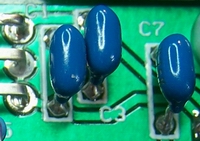 |
|
| C02 | 0.1 µF | SMT 1206 | bottom (black-marked strip) | |
| C03 | 4.7 µF | ceramic | ||
| C04 | 0.01 µF | SMT 1206 | bottom | |
| C05 | 0.01 µF | SMT 1206 | bottom | |
| C06 | 0.01 µF | SMT 1206 | bottom | |
| C07 | 4.7 µF | ceramic | code 475 | |
| misc | shorting wire | 1 | for /ENRX grounding | |
| D1 | 1N4003 | Diode | ||
| U1 | LM7805 | TO-220 5 volt regulator | (top) | |
| U2 | LP2992AIMS-3.3V | SOT23-5 3.3v Regulator | (bottom) |
Installation Notes
Board Hardware
Fasten board mounting hardware
(Pay no attention to the mounting as depicted in the "completed board" pictures - the author got it backward when those pictures were taken. Thanks to Tom Williams K9AC, who commented:
Shouldn't the 4 nylon spacers be on the bottom of the board. They serve no purpose on top since they are shorter than most of the components. The bottom of the board is left in contact with whatever surface it is sitting on. Hopefully, not conductive metal. )
(Pay no attention to the mounting as depicted in the "completed board" pictures - the author got it backward when those pictures were taken. Thanks to Tom Williams K9AC, who commented:
Shouldn't the 4 nylon spacers be on the bottom of the board. They serve no purpose on top since they are shorter than most of the components. The bottom of the board is left in contact with whatever surface it is sitting on. Hopefully, not conductive metal. )
- 3/8” 4-40 screws (4) thru each of the 4 corner mounting holes
- Insert each from bottom of board
- The stack is: screw, 1/8” nylon spacer, (then the board), nylon washer, and hex nut
Bottomside Components
(You may want to refer to the board bottom view)
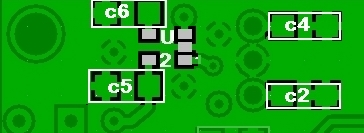
Install U2 (LP2292AIM5-3.3v)
- Install U2 (LP2292AIM5-3.3v) on the bottom side of the board.
- Install this first, so as to avoid having to work around the SMT caps.
- Take care with this IC. It is very tiny and installation is very prone to solder bridges. (see the SMT IC Installation Guidelines).
- Take ESD precautions when working with this IC.
| Check | Designation | Component | Type | Qty | Notes | Orientation |
|---|---|---|---|---|---|---|
| U2 | SOT23-5 LP2992AIMS-3.3V | 3.3v Regulator 3.3v Regulator | (bottom - code="LFEA") | 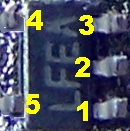
|
Install 4 SMT Caps
Install SMT Capacitors C2, C4, C5, C6 on the bottom of the board. (see guidelines for installing SMT Capacitors)
| Check | Designation | Component | Type |
|---|---|---|---|
| C02 | 0.1 µF |
SMT 1206 (black-marked strip) See caveat on 1206 Caps |
|
| C04 | 0.01 µF | SMT 1206 | |
| C05 | 0.01 µF | SMT 1206 | |
| C06 | 0.01 µF | SMT 1206 |
Topside Components

Install U1 (LM7805)
- Install the 5 volt regulator. It mounts on top of the circuit board and the tab is fastened to the circuit board by 4-40 hardware (4-40 machine screw, #4 star lock washer, and hex nut) provided in the kit.
- Bolt U1 to the board and solder and clip the leads.
| Check | Designation | Component | Type |
|---|---|---|---|
| U1 | LM7805 | TO-220 5 volt regulator |
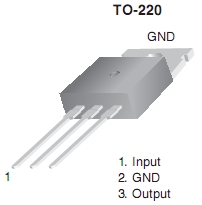
Install D1 (1N4003)
Install D1 "hairpin" style, with the anode end snugged against the round hole and the cathode end as a hairpin into the square hole
| Check | Designation | Component | Type |
|---|---|---|---|
| D1 | 1N4003 | Diode |

Install ceramic Capacitors
Install C1, C3, and C7 topside to the right of U1. See the guidelines on installing Ceramic Capacitors.| Check | Designation | Component | Type |
|---|---|---|---|
| C01 | 4.7 µF (code 475) | ceramic | |
| C03 | 4.7 µF (code 475) | ceramic | |
| C07 | 4.7 µF (code 475) | ceramic |

Finally, Install /ENRX Loop

Install a loop for ground testpoints.
- Install a short piece of hookup wire (the long lead snipped from D1 after its installation is great for this purpose) into the two holes designated "/ENRX" to allow a ground test point and, later, ground the RX Enable signal.
- Note, use a fairly stout piece of wire because this will get a lot of abuse during testing.
| Check | Designation | Component |
|---|---|---|
| misc | shorting wire (e.g., cutoff lead from D1) |
Board as Installed
Top
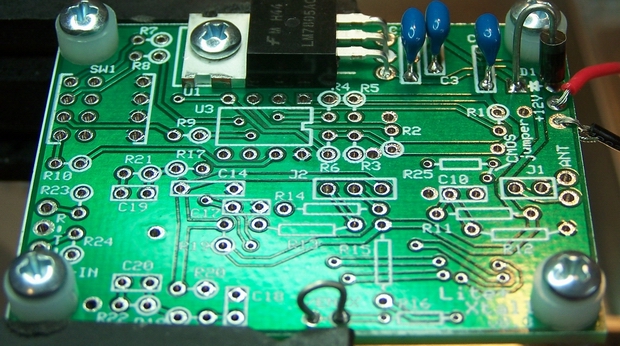
Bottom
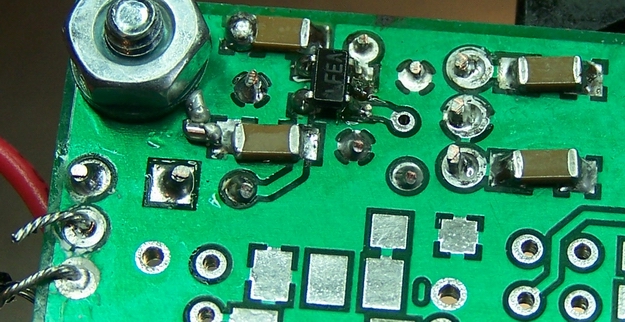
Testing
Current Draw (DMM - 3.1 mA)
- Before you power the board up for the first time, connect a ma meter in series with the power lead and to be safe, put a 1k ohm resistor in series with the power lead. This can be in either the + or - line. This will limit the current flow if you have a short on the board.
- After you see that the current isn't excessive (should be < 5 mA usingf a 9 V battery), remove it, and re-measure the current draw.
- The current draw with this initial stage and no other loads should be on the order of 3.1 mA
- The author's board measured 3.12 mA with a $30 DMM).
5 Volt Rail (DMM - 5 Vdc)
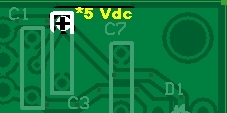
- Using a DMM, measure the voltage with respect to ground at the top end of C3.
- This should be approximately 5 volts DC.
- The author's board measured 4.98 Vdc).
3.3 Volt Rail (DMM - 3.3 Vdc)
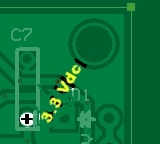
- Using a DMM, measure the voltage with respect to ground at the lower end of C7.
- This should be approximately 3.3 volts DC (the author's board provided 3.29 Vdc).
- If you do not get a good 3.3 Vdc reading, go back and check the soldering on the IC. (The author's first test actually yielded only 1.6 mV. The problem turned out to be a poor solder joint on pin 2 of U2.)